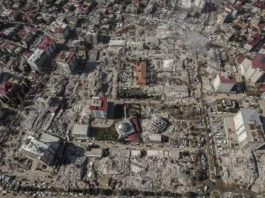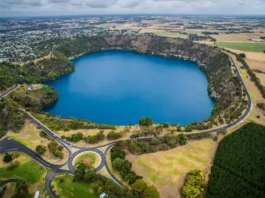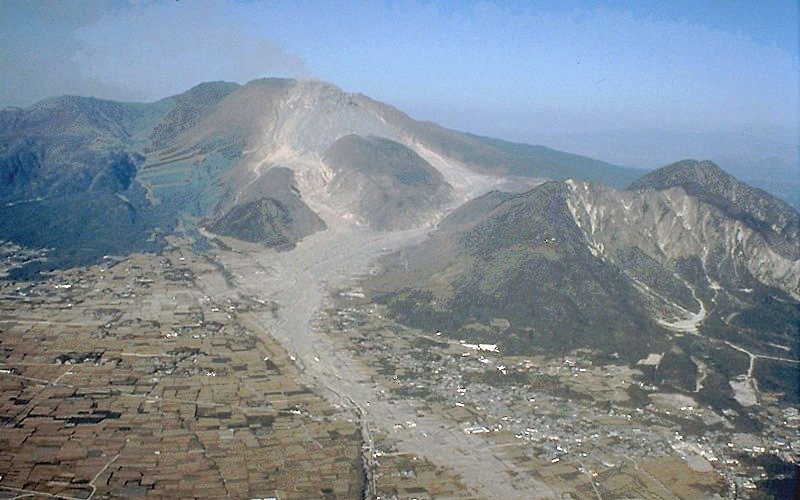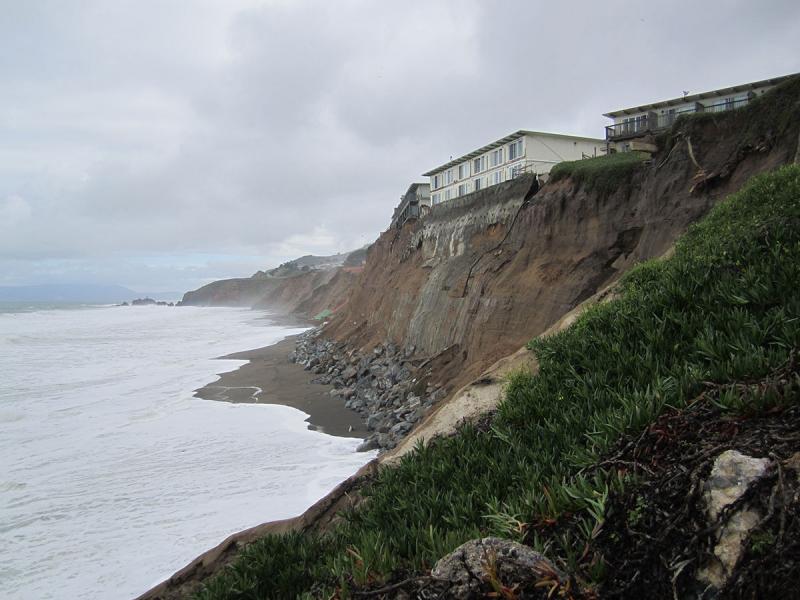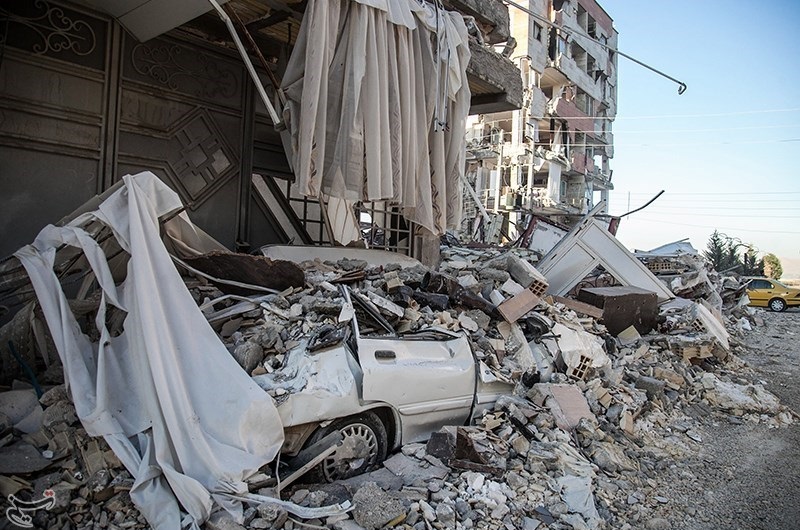Sinkhole is a ground that is formed by the collapse of the surface layer and has no external drainage. When it rains, the water stays in the sinkhole. Sinkholes can range from a few feet to hundreds of acres and less than 1 to 100 feet deep. Some are in the form of shallow bowls or plates, while others have vertical walls; some hold water and form natural ponds.
The majority of sinkholes are formed by karstic processes. It is formed by the chemical dissolution of carbonate rocks. Sinkholes are generally circular. Sinkholes can occur gradually or suddenly and are found worldwide. Typically, sinkholes form so slowly that little change is noticeable, but they can form suddenly when a collapse occurs. As the rock dissolves, cavities and caves develop underground. If there is not enough support for the land above the gaps, a sudden collapse of the land surface can occur. Sinkholes are most common in what geologists call “karst terrain.” These are regions where rock types below the land surface can dissolve naturally by groundwater circulating through them. Soluble rocks include salt deposits and domes, gypsum, limestone, and other carbonate rocks.

Contents
Formation
It involves natural erosion or the gradual removal of poorly soluble bedrock (such as limestone) through infiltration of water, collapse of a cave roof, or lowering of the water table. Rain that seeps or seeps through the soil absorbs carbon dioxide and reacts with decaying vegetation to form a slightly acidic water. This water passes through underground cavities and cracks, gradually dissolving the limestone, creating a network of voids and voids. As the limestone dissolves, the pores and cracks expand and carry more acidic water. Sinkholes form when the land surface above subsides or sinks into voids, or when surface material is transported downwards into voids.
Sometimes a sinkhole can show a visible opening to a cave below. In the case of extraordinarily large sinkholes such as the Minyé sinkhole in Papua New Guinea or the Cedar Sink in Mammoth Cave National Park in Kentucky, an underground stream or river can be seen flowing from side to side.
Sinkholes are common where the rock below the land surface is limestone or other carbonate rocks, salt deposits or other soluble rocks such as gypsum and can be dissolved naturally by the circulation of groundwater. Sinkholes are also seen in sandstone and quartzite terrains.
As the rock dissolves, cavities and caves develop underground.
Drought, together with the resultant high groundwater withdrawal, can create favorable conditions for sinkholes to form. Also, heavy rains after droughts often cause enough pressure on the ground to form sinkholes.
Occurrence
The sinkholes are considered to be designed in karst landscapes. Karst landscapes a small vertical landscape and gives a view to the landscape. This sinkhole drains all the water, there are only rivers of water for these additional services.
Some sinkholes are formed in thick limestone layers. Their formation is facilitated by good watering, as they will be caused by high falls; such precipitation causes works of giant sinkholes in the Nakanaï Mountains on the island of New Britain in Papua New Guinea. Problems with its mighty rivers, limestone and rocks falling from below.
This is the largest sinkhole in the world, such as the 662-metre (2,172 ft) Xiaozhai Tiankeng (Chongqing, China), giant sótanos in Querétaro, and San Luis Potosí states in Mexico and others.
It can be experienced in Florida in North America of the USA with frequent fallouts in the central part of certain state. The underlying cancerstone is between 15 and 25 million years old. In your state, sinkholes are rare or absent; There is limestone that is 120,000 years old.
There are also many sinkholes in the Murge region in Southern Italy. Because of the large amount of sinkholes in the rains.
Human Uses
Sinkholes are used as kitchens for standard equipment arrays. To come to a conclusion on this, such use is to die for from its health-promoting water
The Mayan civilization uses the sinkholes of the ancient Yucatán Peninsula as places to place things and people’s lives.
The sinkhole can offer very large area or cave-related areas, cavers or water-filled divers. Among the best are the Zacatón cenote (the world’s deepest flooded sinkhole) in Mexico, the Boesmansgat sinkhole in South Africa, the Sarisariñama tepuy in Venezuela, the Mexican town of Sótano del Barro and the South Australian town of Gambier. . The sinkholes formed on coral reefs and very deep collapsed islands are blue as they are knowledgeable and go from spots in their personalities.
Sinkholes can be actuated by people
- Being steered from a large area on the surface and steered from a single field of view
- Artificially creating pools of surface water
- Drilling new water wells
- It is dangerous for urban roads, sinkholes areas and buildings. Sinkholes can also cause water quality problems. Surface waters can seep into the aquifer through subsidence.
Warning signs
A rapid sinkhole from pit drilling or other sudden changes in terrain may not give any warning signs. Otherwise, the collapse process usually happens slowly enough for a person to safely leave the affected area. The final breakthrough can develop over a period of a few minutes to several hours.
Some warning signs of a naturally occurring sinkhole include:
- Gradual localized ground layout
- Doors and windows do not close properly
- Cracks in a foundation
- A circular pattern of ground cracks surrounding the sinking area
- Vegetation stress due to lowered water table
- Turbidity in local well water due to sediment entering pores of limestone
- There are many other causes of local ground settlement and vegetation stress, and sunken areas are not necessarily a sign of imminent sinkholes.
Sinkhole Types
Dissolution Sinkholes
The guidance of limestone or dolomite is most intense on the ground at the first contact of water with the rock. Aggressive can also be experienced in ground joints, rounds and bedding, as well as while targeting spherical joints, rounds and hovering over the water table, which also follows the same course.
It is filtered through joints in precipitation and limestone on its surface. A small depression of dissolved carbonate rock gradually forms from the surface. In exposed carbon calender, you can progress to non-direction by being driven into a collapse. Debris carried into the developing sinkhole, you can get out, decorate the pond and wetland. Gently rolling hills and shallow depressions caused by solution sinkholes are common topographic features of Florida.

Cover-Subsidence Sinkholes
Covered submerged sinkholes tend to develop gradually where the overlying sediments are permeable and contain sand. In areas where the cover material is thicker or the sediments contain more clay, cover subsidence sinkholes are relatively rare, smaller and may go unnoticed for long periods of time.
Granular sediments are poured into secondary openings in the underlying carbonate rocks.
An overlying column of sediment settles into empty spaces (a process called “piping”).
The thawing and filling continues, creating a visible depression on the land surface.
Slowly downward erosion eventually creates small surface depressions from 1 inch to several feet in depth and diameter.
In areas where the cover material is thicker or the sediments contain more clay, cover subsidence sinkholes are relatively rare, smaller and may go unnoticed for long periods of time.

Source: Land Subsidence in the United States, USGS
Cover-Collabse Sinkholes
Closure-collapse sinkholes can develop suddenly (within a few hours) and cause catastrophic damage. They occur where cover sediments contain significant amounts of clay. Over time, surface drainage, erosion, and accumulation of sinkhole pit in a shallower bowl-shaped depression. Over time, surface drainage, erosion, and sediment deposition transform the steep-walled sinkhole into a shallower bowl-shaped depression.
Sediments are poured into a cavity
As shedding continues, cohesive cover deposits form a structural belt.
The gap moves upward with gradual roof collapse.
The void eventually breaks the ground surface and creates sudden and dramatic sinkholes.

Some of the largest sinkholes in the world are
Blue Hole – Dahab, Egypt. A round sinkhole or blue hole, 130 m (430 ft) deep. It includes an archway leading out to the Red Sea at 60 m (200 ft), which has been the site for many freediving and scuba attempts, the latter often fatal
Boesmansgat – South African freshwater sinkhole, approximately 290 m (950 ft) deep
Lake Kashiba – Zambia. About 3,5 hectares (8,6 acres) in area and about 100 m (330 ft) deep.
Akhayat sinkhole is in Mersin Province, Turkey. Its dimensions are about 150 m (490 ft) in diameter with a maximum depth of 70 m (230 ft).
Well of Barhout – Yemen. A 112-metre (367 ft) deep pit cave in Al-Mahara, Yemen.
Bimmah Sinkhole (Hawiyat Najm, the Falling Star Sinkhole, Dibab Sinkhole) – Oman, approximately 30 m (98 ft) deep.
The Baatara gorge sinkhole and the Baatara gorge waterfall next to Tannourine in Lebanon
Dashiwei Tiankeng in Guangxi, China, is 613 m (2,011 ft) deep, with vertical walls. At the bottom is an isolated patch of forest with rare species.
The Dragon Hole, located south of the Paracel Islands, is the deepest known underwater ocean sinkhole in the world. It is 300,89 m (987,2 ft) deep.
Shaanxi tiankeng cluster, in the Daba Mountains of southern Shaanxi, China, covers an area of nearly 5019 square kilometers[67] with the largest sinkhole being 520 meters in diameter and 320 meters deep
Teiq Sinkhole (Taiq, Teeq, Tayq) in Oman is one of the largest sinkholes in the world by volume: 90.000.000 m3 (3,2×109 cu ft). Several perennial wadis fall with spectacular waterfalls into this 250 m (820 ft) deep sinkhole.
Xiaozhai Tiankeng – Chongqing, China. Double nested sinkhole with vertical walls, 662 m (2,172 ft) deep.
Dean’s Blue Hole – Bahamas. The second deepest known sinkhole under the sea, depth 203 m (666 ft). Popular location for world championships of free diving, as well as recreational diving.
Hranice Abyss, in the Moravia region of the Czech Republic, is the deepest known underwater cave in the world. The lowest confirmed depth (as of 27 September 2016) is 473 m (404 m below the water level).
Pozzo del Merro, near Rome, Italy. At the bottom of an 80 m (260 ft) conical pit, and approximately 400 m (1,300 ft) deep, it is among the deepest sinkholes in the world (see Sótano del Barro below)
Red Lake – Croatia. Approximately 530 m (1,740 ft) deep pit with nearly vertical walls, contains an approximately 280–290 m (920–950 ft) deep lake.
Gouffre de Padirac – France. It is 103 m (338 ft) deep, with a diameter of 33 metres (108 ft). Visitors descend 75 m via a lift or a staircase to a lake allowing a boat tour after entering into the cave system which contains a 55 km subterranean river.
Vouliagmeni – Greece. The sinkhole of Vouliagmeni is known as “The Devil Well”, because it is considered extremely dangerous. Four scuba divers have died in it. Maximum depth of 35.2 m (115 ft 6 in) and horizontal penetration of 150 m (490 ft).
Cave of Swallows – San Luis Potosí. 372 m (1,220 ft) deep, round sinkhole with overhanging walls.
Puebla sinkhole – Santa Maria Zacatepec, Puebla. 120 m (400 ft) diameter and 15 m (50 ft) deep, it is still growing as of June 2021. 2021
Sima de las Cotorras – Chiapas. 160 m (520 ft) across, 140 m (460 ft) deep, with thousands of green parakeets and ancient rock paintings.
Zacatón – Tamaulipas. Deepest water-filled sinkhole in world, 339 m (1,112 ft) deep.[further explanation needed]
Amberjack Hole – blue hole located 48 km (30 mi) off the coast of Sarasota, Florida.
Bayou Corne sinkhole – Assumption Parish, Louisiana. About 25 acres in area[75] and 230 m (750 ft) deep.
The Blue Hole – Santa Rosa, New Mexico. The surface entrance is only 80 feet (24 m) in diameter, it expands to a diameter of 130 feet (40 m) at the bottom.
Daisetta Sinkholes – Daisetta, Texas. Several sinkholes have formed, the most recent in 2008 with a maximum diameter of 620 ft (190 m) and maximum depth of 45 m (150 ft)
Devil’s Millhopper – Gainesville, Florida. 35 m (120 ft) deep, 500 ft (150 m) wide. Twelve springs, some more visible than others, feed a pond at the bottom
Golly Hole or December Giant – Calera, Alabama. Appeared 2 December 1972. Approximately 300 ft (91 m) by 325 ft (99 m) and 35 m (120 ft) deep
Green Banana Hole – a blue hole located 80 km (50 mi) off the coast of Sarasota, Florida.
Gypsum Sinkhole – Utah, in Capitol Reef National Park. Nearly 15 m (49 ft) in diameter and approximately 60 m (200 ft) deep
Kingsley Lake – Clay County, Florida. 8.1 km2 (2,000 acres) in area, 27 m (89 ft) deep and almost perfectly round.
Lake Peigneur – New Iberia, Louisiana. Original depth 3.4 m (11 ft), currently 400 m (1,300 ft) at Diamond Crystal Salt Mine collapse
Winter Park Sinkhole – Winter Park, Florida. Appeared 8 May 1981. It was approximately 110 m (350 ft) wide and 25 m (75 ft) deep. It was notable as one of the largest recent sinkholes to form in the United States. It is now known as Lake Rose
Harwood Hole – Abel Tasman National Park, New Zealand. 183 m (600 ft) deep.
Minyé sinkhole – East New Britain, Papua New Guinea. 510 m (1,670 ft) deep, with vertical walls, crossed by a powerful stream.
Sima Humboldt – Bolívar, Venezuela. Largest sinkhole in sandstone, 314 m (1,030 ft) deep, with vertical walls. Unique, isolated forest on bottom.
References
- How sinkholes form – SJRWMD. (2022). Retrieved 11 March 2022, from https://www.sjrwmd.com/education/sinkholes/
- Sinkholes | U.S. Geological Survey. (2022). Retrieved 11 March 2022, from https://www.usgs.gov/special-topics/water-science-school/science/sinkholes
- Gutiérrez, F. Sinkhole Hazards. Oxford Research Encyclopedia of Natural Hazard Science. Retrieved 11 Mar. 2022, from https://oxfordre.com/naturalhazardscience/view/10.1093/acrefore/9780199389407.001.0001/acrefore-9780199389407-e-40.
- What is a sinkhole? | U.S. Geological Survey. (2022). Retrieved 11 March 2022, from https://www.usgs.gov/faqs/what-sinkhole#faq
- Wikipedia contributors. (2022, February 21). Sinkhole. In Wikipedia, The Free Encyclopedia. Retrieved 21:31, March 11, 2022, from https://en.wikipedia.org/w/index.php?title=Sinkhole&oldid=1073115118

